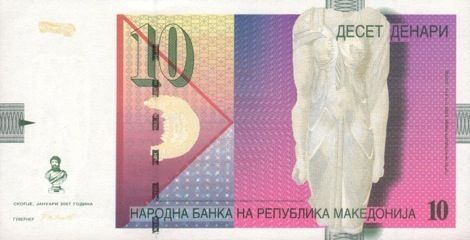Macedonia
Macedonia new date (00.05.2018) 100-denari note (B208l) confirmed
16 06, 2018 06:56 Category: Europe

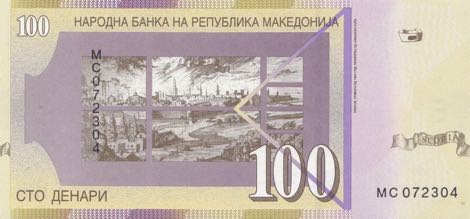
Like B208k, but new date (MАЈ 2018). Prefix MC.
Courtesy of Darko Berger.
Macedonia new 10- and 50-denar polymer notes (B217, B218) confirmed
16 05, 2018 09:49 Category: Europe
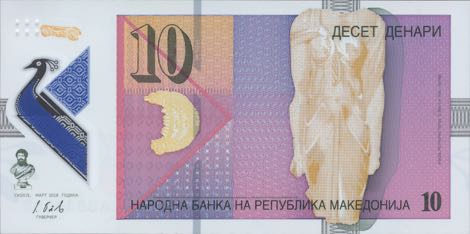

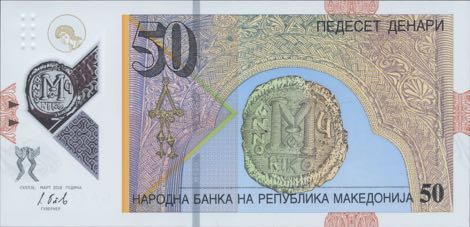

These notes are like the preceding issues, but printed on polymer substrate, not paper.
Courtesy of James Pickering (e-worldbanknotes.com).
Macedonia new 10- and 50-denar polymer notes reported for 15.05.2018 introduction
10 04, 2018 11:49 Category: Europe
According to an article on Sitel.com dated 8 April 2018, the National Bank of the Republic of Macedonia plans to replace the existing 10- and 50-denar paper notes with new polymer notes on 15 May 2018.
Courtesy of Martin Grupcev.
Courtesy of Martin Grupcev.
Macedonia new date (00.12.2016) 1,000-denar note (B214d) confirmed
02 03, 2017 17:36 Category: Europe

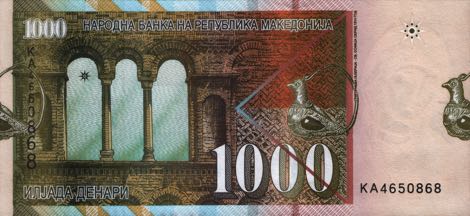
Like B214c, but new date (Декември 2016). Prefix KA.
Courtesy of Martin Grupcev.
Macedonia new 200- and 2,000-denar notes (B215, B216) confirmed
23 12, 2016 09:29 Category: Europe
Two years after initially unveiling their designs, the National Bank of the Republic of Macedonia introduced banknotes in the new denominations of 200- and 2,000-denar on 15 December 2016, and is withdrawing current 5,000-denar banknotes (B211) to rebalance the structure of banknotes in circulation. Commercial banks will replace 5,000-denar notes from 15 December 2016 up to 28 February 2017. As of 1 March 2017, they will be exchangeable only at the National Bank of the Republic of Macedonia.
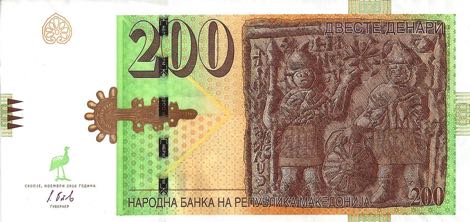
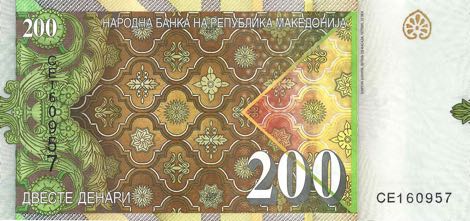
B215 (PNL): 200 денари (denari) (US$3.60)
Green, orange, yellow, and brown. Front: Leaf as registration device; bird; 7th-century medieval bow bronze fibula (brooch) found near Prilep; 6-7th century Christian terracotta icon from Vinica of warriors Joshua and Caleb wearing armor, holding spears and shield, illustrating Old Testament (The Book of Joshua) episode when Joshua stops the sun over Gibeon and the moon over the valley of Aijalon, before the victory of the Israelites over the Amorites. Back: Floral and star pattern from front facade of the Šarena (Aladža) Džamija in Tetovo and from marble floor tiles of 16th-century Ishak Çelebi Mosque in Bitola. Pearlescent stripe with 200 and star pattern. Red-to-green windowed security thread with demetalized НБРМ 200. Watermark: Star, electrotype 200, and Cornerstones. Printer: (TDLR). 144 x 68 mm.
a. 2016. Signature 7. Intro: 15.12.2016.

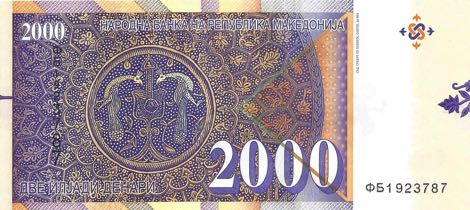
B216 (PNL): 2,000 денари (denari) (US$36)
Purple, orange, yellow, and green. Front (vertical): Early Christian mosaic as registration device; 7th-century bronze poppy cup pendant; woman wearing Macedonian bridal costume; green-to-blue SPARK element. Back: Christian mosaic decoration of two peacocks (birds of paradise) near the “source of life” inside 16th-century gilded vessel. Pearlescent stripe with 2000 and star pattern. Red-to-green windowed security thread with demetalized НБРМ 2000. Watermark: Macedonian bridal costume, electrotype 2000, and Cornerstones. Printer: (TDLR). 152 x 70 mm.
a. 2016. Signature 7. Intro: 15.12.2016.
Courtesy of James Pickering (e-worldbanknotes.com).


B215 (PNL): 200 денари (denari) (US$3.60)
Green, orange, yellow, and brown. Front: Leaf as registration device; bird; 7th-century medieval bow bronze fibula (brooch) found near Prilep; 6-7th century Christian terracotta icon from Vinica of warriors Joshua and Caleb wearing armor, holding spears and shield, illustrating Old Testament (The Book of Joshua) episode when Joshua stops the sun over Gibeon and the moon over the valley of Aijalon, before the victory of the Israelites over the Amorites. Back: Floral and star pattern from front facade of the Šarena (Aladža) Džamija in Tetovo and from marble floor tiles of 16th-century Ishak Çelebi Mosque in Bitola. Pearlescent stripe with 200 and star pattern. Red-to-green windowed security thread with demetalized НБРМ 200. Watermark: Star, electrotype 200, and Cornerstones. Printer: (TDLR). 144 x 68 mm.
a. 2016. Signature 7. Intro: 15.12.2016.


B216 (PNL): 2,000 денари (denari) (US$36)
Purple, orange, yellow, and green. Front (vertical): Early Christian mosaic as registration device; 7th-century bronze poppy cup pendant; woman wearing Macedonian bridal costume; green-to-blue SPARK element. Back: Christian mosaic decoration of two peacocks (birds of paradise) near the “source of life” inside 16th-century gilded vessel. Pearlescent stripe with 2000 and star pattern. Red-to-green windowed security thread with demetalized НБРМ 2000. Watermark: Macedonian bridal costume, electrotype 2000, and Cornerstones. Printer: (TDLR). 152 x 70 mm.
a. 2016. Signature 7. Intro: 15.12.2016.
Courtesy of James Pickering (e-worldbanknotes.com).
Macedonia new sig/date (00.12.2014) 500-denar note (B213c) confirmed
11 11, 2015 16:01 Category: Europe


Like B213b, but new date (Декември 2014) and new signature. Prefix EИ.
Courtesy of Hartmut Fraunhoffer (Banknote-Online).
Macedonia new sig/date (00.12.2013) 100-denar note (B208k) confirmed
03 06, 2015 12:26 Category: Europe
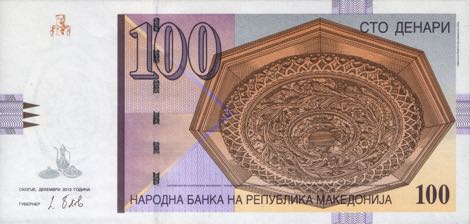
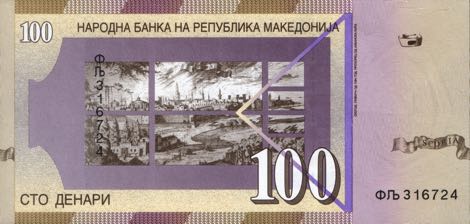
Like B208j, but new date (Декември 2013) and new signature (Dimitar Bogov).
Courtesy of Martim Grupcev.
Macedonia new sig/date (00.10.2013) 1,000-denar note (B214c) confirmed
11 03, 2014 07:38 Category: Europe
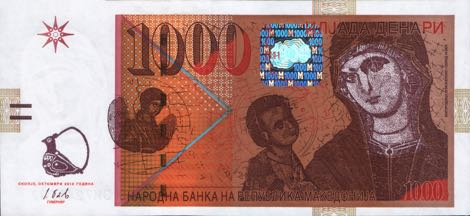
Like B214b, but new date (Октомври 2013) and new signature (Dimitar Bogov).
Courtesy of Peter Mosselberger (http://www.banknote.ws).
Book review: Coins and Banknotes of Yugoslavia, Slovenia, Croatia, Bosnia and Herzegovina, Serbia, Montenegro and Macedonia
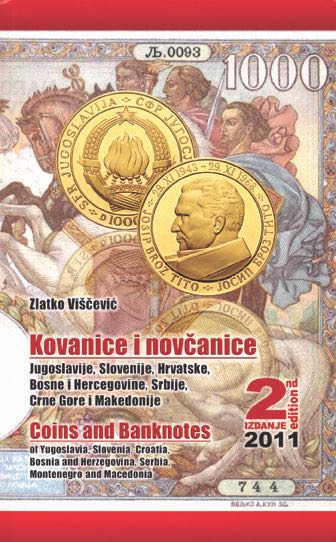
Coins and Banknotes of Yugoslavia, Slovenia, Croatia, Bosnia and Herzegovina, Serbia, Montenegro and Macedonia
Zlatko Viščević, 1173 pages, soft cover, 192 x 120 mm, black and white illustrations, Croatian and English, ISBN 978-953-56890-0-3, US$52 / €40 (free shipping), kin2.orders@gmail.com
Download the free sample chapter: Coins and Banknotes of the Kingdom of Yugoslavia.
Reviewed by Owen W. Linzmayer 7962
As author Zlatko Viščević mentions in the introduction to his impressive new catalog, collecting banknotes from the area of the former Yugoslavia can be quite challenging due to the large number of notes issued over the years. Compounding the problem is the Serbo-Croatian text on these notes and the complicated history of the region, both of which may be unfamiliar to many collectors. This new catalog doesn’t attempt to explain the tumultuous politics of the past three centuries, but is an invaluable addition to the reference library of anyone who specializes in collecting notes from this part of the world.
The first edition of this catalog was published in 2007. The second edition covers regular and commemorative notes issued in the intervening years, goes into greater depth in the descriptions, and now also includes special, fantasy, and private issues. In short, if you already own the first edition and like it, you’ll definitely want to buy the much-improved and expanded second edition.
Coins and Banknotes’ title spells out exactly what’s inside. The first half of the book is devoted to coins, the second half to notes, with chapters for the seven countries in each section. Within the chapters, the coins and notes are listed chronologically by denomination, which makes it easy to locate a particular piece and track changes over time, but at the expense of presenting complete families with common or complementary designs.
Each note type listing contains the denomination, catalog number, cross-references to Pick numbers and other specialized catalogs, reduced-size illustrations of the front and back, description of design elements and security features, and finally a list of varieties, with checkboxes for tracking your collection. Each variety is assigned a six-level rarity rating, and has values in euros for up to four levels of condition. Some notes also have auction results at the bottom of the page, though the values and results don’t always agree. Occasionally there are inset illustrations of details which determine varieties. These are useful in most cases, but sometimes the differences aren’t obvious due to the small size or lack of color in their reproduction.
Specialized collectors will appreciate the comprehensive lists of prefixes, as well as the inclusion of specimen and replacement notes in the variety tables, not to mention the assortment of “irregular issues” (color trials, partial proofs, etc.) and private/fantasy notes covered separately. While there isn’t much explanatory text regarding these issues, anyone interested in pursuing further research can consult the bibliography of source books and web sites at the end of each chapter.
The longer passages of prose in the catalog are presented in both Croatian and English, but the descriptions of the notes and their varieties are in Croatian only, which is a little frustrating if you care about such details and don’t want to rely upon Google Translate. Fortunately the English text everywhere else in the book is good enough that it’s easy to overlook the minor typos and understand the gist of the intended meaning.
One complaint I have about the catalog is its size. This is a bulky, compact tome measuring a whopping 55 millimeters thick, and heavy enough to break a toe if dropped on a foot. I would have preferred the coin and banknote sections split into two separate volumes, both printed in a larger format. As it is, the small black and white illustrations don’t do justice to the beauty of the notes, and the tiny text is hard to read if your eyesight isn’t perfect.
With this second edition, Zlatko Viščević has created a solid reference for collectors of notes of Yugoslavia and its constituent republics from 1849 to 2011. Coins and Banknotes delivers a dense helping of numismatic information at price that can’t be beat.
Macedonia new sig/date (00.12.2011) 10-denar note (B206i) confirmed
04 10, 2012 09:50 Category: Europe
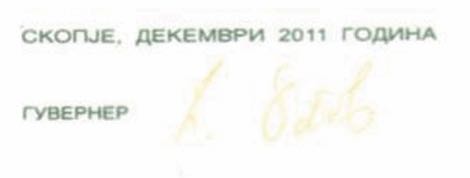
Like B206h, but new date (Декември 2011) and signature (Dimitar Bogov).
Courtesy of Hartmut Fraunhoffer (www.banknoten.de).
Book Review: Coins and Banknotes of Yugoslavia, Slovenia, Croatia, Bosnia and Herzegovina, Serbia, Montenegro and Macedonia

Coins and Banknotes of Yugoslavia, Slovenia, Croatia, Bosnia and Herzegovina, Serbia, Montenegro and Macedonia
Zlatko Viščević, 1173 pages, soft cover, 192 x 120 mm, black and white illustrations, Croatian and English, ISBN 978-953-56890-0-3, US$52 / €40 plus shipping, www.hrvatskanumizmatika.net
Download the free sample chapter: Coins and Banknotes of the Kingdom of Yugoslavia.
Reviewed by Owen W. Linzmayer 7962
As author Zlatko Viščević mentions in the introduction to his impressive new catalog, collecting banknotes from the area of the former Yugoslavia can be quite challenging due to the large number of notes issued over the years. Compounding the problem is the Serbo-Croatian text on these notes and the complicated history of the region, both of which may be unfamiliar to many collectors. This new catalog doesn’t attempt to explain the tumultuous politics of the past three centuries, but is an invaluable addition to the reference library of anyone who specializes in collecting notes from this part of the world.
The first edition of this catalog was published in 2007. The second edition covers regular and commemorative notes issued in the intervening years, goes into greater depth in the descriptions, and now also includes special, fantasy, and private issues. In short, if you already own the first edition and like it, you’ll definitely want to buy the much-improved and expanded second edition.
Coins and Banknotes’ title spells out exactly what’s inside. The first half of the book is devoted to coins, the second half to notes, with chapters for the seven countries in each section. Within the chapters, the coins and notes are listed chronologically by denomination, which makes it easy to locate a particular piece and track changes over time, but at the expense of presenting complete families with common or complementary designs.
Each note type listing contains the denomination, catalog number, cross-references to Pick numbers and other specialized catalogs, reduced-size illustrations of the front and back, description of design elements and security features, and finally a list of varieties, with checkboxes for tracking your collection. Each variety is assigned a six-level rarity rating, and has values in euros for up to four levels of condition. Some notes also have auction results at the bottom of the page, though the values and results don’t always agree. Occasionally there are inset illustrations of details which determine varieties. These are useful in most cases, but sometimes the differences aren’t obvious due to the small size or lack of color in their reproduction.
Specialized collectors will appreciate the comprehensive lists of prefixes, as well as the inclusion of specimen and replacement notes in the variety tables, not to mention the assortment of “irregular issues” (color trials, partial proofs, etc.) and private/fantasy notes covered separately. While there isn’t much explanatory text regarding these issues, anyone interested in pursuing further research can consult the bibliography of source books and web sites at the end of each chapter.
The longer passages of prose in the catalog are presented in both Croatian and English, but the descriptions of the notes and their varieties are in Croatian only, which is a little frustrating if you care about such details and don’t want to rely upon Google Translate. Fortunately the English text everywhere else in the book is good enough that it’s easy to overlook the minor typos and understand the gist of the intended meaning.
One complaint I have about the catalog is its size. This is a bulky, compact tome measuring a whopping 55 millimeters thick, and heavy enough to break a toe if dropped on a foot. I would have preferred the coin and banknote sections split into two separate volumes, both printed in a larger format. As it is, the small black and white illustrations don’t do justice to the beauty of the notes, and the tiny text is hard to read if your eyesight isn’t perfect.
With this second edition, Zlatko Viščević has created a solid reference for collectors of notes of Yugoslavia and its constituent republics from 1849 to 2011. Coins and Banknotes delivers a dense helping of numismatic information at price that can’t be beat.
Macedonia chapter of The Banknote Book is now available
05 08, 2011 08:52 Category: The Banknote Book | Europe
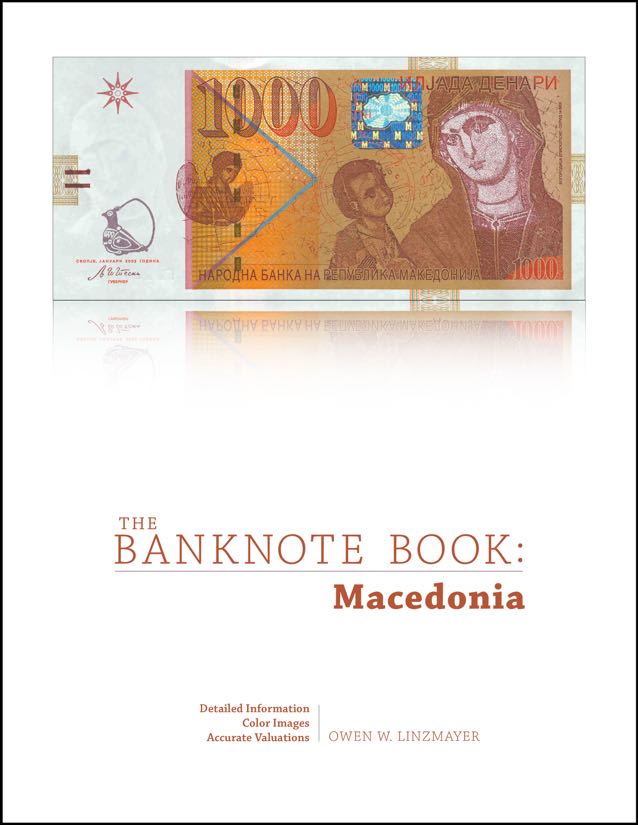
The Macedonia chapter of The Banknote Book is now available for individual sale and as a free download to subscribers.
This 8-page catalog covers notes issued by the National Bank of Macedonia in 1992, and the National Bank of the Republic of Macedonia from 1993 to present. Revised 11 November 2015.
Each chapter of The Banknote Book includes detailed descriptions and background information, full-color images, and accurate valuations. The Banknote Book also features:
- Sharp color images of note’s front and back without overlap
- Face value or date of demonetization if no longer legal tender
- Specific identification of all vignette elements
- Security features described in full
- Printer imprint reproduced exactly as on note
- Each date/signature variety assigned an individual letter
- Variety checkboxes for tracking your collection and want list
- Date reproduced exactly as on note
- Precise date of introduction noted when known
- Replacement note information
- Signature tables, often with names and terms of service
- Background information for historical and cultural context
- Details magnified to distinguish between note varieties
- Bibliographic sources listed for further research
Subscribe to The Banknote Book
If you collect the entire world or a large number of countries, buying a subscription is the best deal because it's less expensive than buying chapters individually, and it entitles you to every chapter currently available as well as everything published—or revised (click here to see the Change Log)—during the term of your subscription.

Sign up for Email Notifications
If you would like to receive email notifications whenever a new chapter of The Banknote Book is published, please join the email list.

Macedonia new date (00.09.2008) 100-denar note (B208i) confirmed
12 04, 2011 17:22 Category: Europe
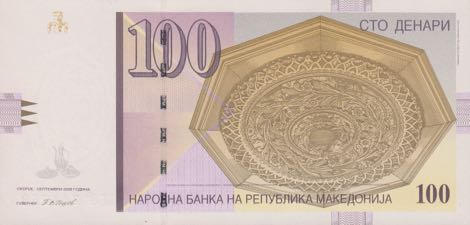
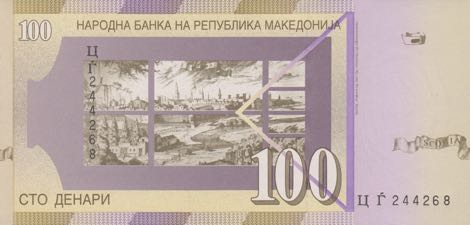
Like B208h, but new date (СЕПТЕМВРИ 2008).
Courtesy of Thomas Augustsson.
Macedonia new sig/date (00.01.2009) 100-denar note (B208j) confirmed
28 11, 2010 15:51 Category: Europe
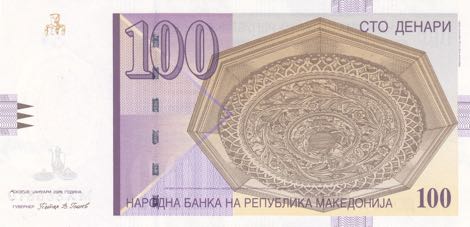

Like B208i, but new date (ЈАНУАРИ 2009) and new signature (Petar Goshev).
Courtesy of Matej Omahen.
Macedonia new sig/date (00.01.2009) 500-denar note (B213b) confirmed
30 08, 2010 11:54 Category: Europe
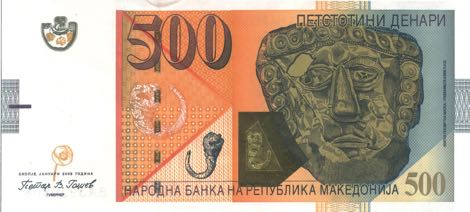
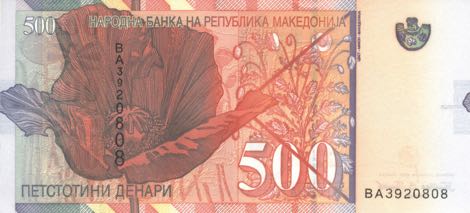
Like B213a, but new date (ЈАНУАРИ 2009) and new signature (Petar Goshev).
Courtesy of Claudio Marana.
Macedonia new sig/date (00.01.2009) 1,000-denar note (B214b) confirmed
12 09, 2010 11:56 Category: Europe
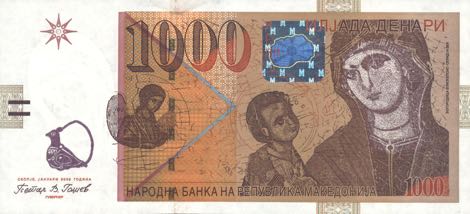
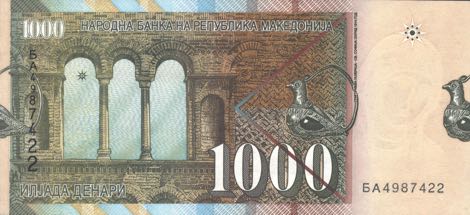
Like B214a, but new date (ЈАНУАРИ 2009) and new signature (Petar Goshev).
Courtesy of Claudio Marana.
Macedonia new date (00.01.2008) 10-denar note (B206h) confirmed
04 03, 2009 19:33 Category: Europe
Macedonia new date (00.01.2006) 10-denar note (B206f) confirmed
27 12, 2006 09:39 Category: Europe
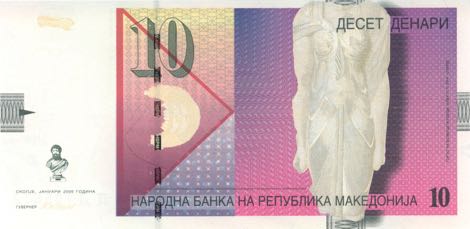
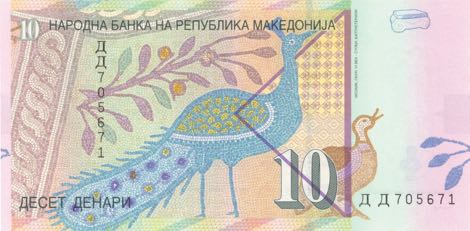
Like B206e, but new date and signature (Petar Goshev, Governor).
Courtesy of Olexandr Danishenko.
Macedonia new date (00.01.2007) 10-denar note (B206g) confirmed
12 04, 2007 17:14 Category: Europe

